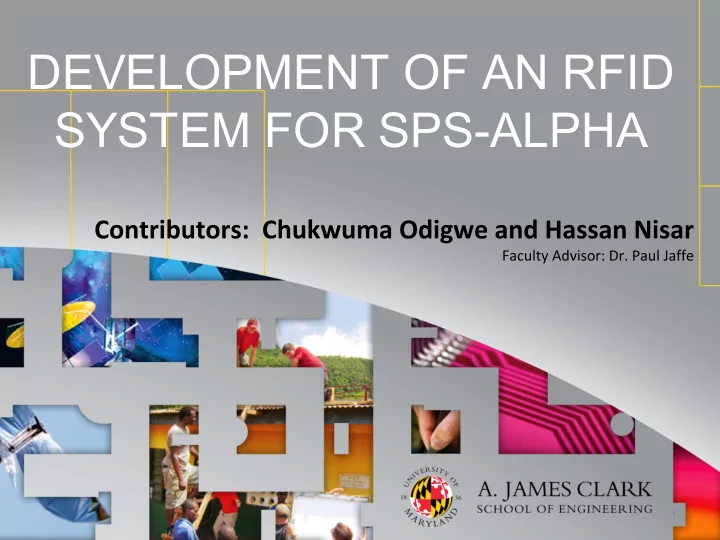

DEVELOPMENT OF AN RFID SYSTEM FOR SPS-ALPHA 1
OBJECTIVES RFID Implementation: ▪ SPS-ALPHA Structure ▪ RFID Technology ▪ Applications in SPS-ALPHA architecture ▪ Part Identification ▪ Location Referencing 2
Why Space Solar ▪ No atmospheric attenuation of sunlight ▪ No Day and Night cycle ▪ No weather losses 3
SPS-ALPHA overview 4
Modules and Assemblies 5
Modular Autonomous Robotic Effectors (MARE) 6
Radio Frequency Identification (RFID) Technology ▪ Capable of sending data short distances ▪ Currently used in the ISS 7
Types of RFID ▪ Passive and active RFID tags ▪ Passive RFID tags do not require an internal battery; active RFID tags do ▪ Read only and Read-Write tags 8
How RFID is used ▪ RFID system consists of a reader and a tag ▪ Reader sends an electromagnetic signal to tag ▪ Tag sends data back by switching its input impedance between two states (high and low) Passive RFID Circuit Diagram 9
RFID Tag Selection Passive RFID Tag Ranges Frequency Transmission Range Low Frequency 125 kHz Less than 1 foot High Frequency 13.56 MHz Up to 3 feet Ultra High Frequency 865 to 960 MHz 30+ feet Microwave 2.4 to 2.5 GHz 100 + feet 10
Why use RFID? ▪ Can be very small-capable of being embedded in SPS-ALPHA components ▪ Cost-effective ▪ Long-lasting ▪ Can be used in harsh environments ▪ Fast read & write time 11
Example RFID Components ▪ AMS SL13A RFID Sensor Tag: ▪ Operates at 13.56 MHz ▪ Capable of operating from -40 ℃ ~ 110 ℃ ▪ 1 kB writable memory ▪ Texas Instruments TRF7960A Reader/Writer IC: ▪ Operates at 13.56 MHz ▪ Capable of operating from -40 ℃ ~ 110 ℃ 12
Part Identification System ▪ 8 different modules ▪ Need at least 3 bits to represent them. ▪ 6 different assemblies ▪ Need at least 3 bits to represent them. ▪ 4 byte Unique ID 00000101 = 13
Representing Location Part Identification System Data Structure Byte width: 128 874 4 4 4 4 1 1 Parity Operations Log Z Pos Y Pos X Pos Unique ID Assembly Module Field Field Field 14
Operations Log Structure of Operations Log Entries Byte Width: 8 4 1 1 MARE Time Damage Health ID Structure of the Time Field Bit Width: 12 4 5 5 6 Year Month Date Hour Minute 15
Error Correction ▪ Reed-Solomon error correction code ▪ RS(255,223), k = 223 symbols , 2t = 32 symbols ▪ 8-bit wide symbols RFID RFID RS(255,223) Data RS(255,223) Tag Tag Decoder Modification Encoder 255 symbols 223 symbols 32 symbols DATA PARITY 16
Future Work ▪ RFID Tag Interference 17
Conclusion ▪SPS-ALPHA Structure ▪RFID Technology ▪Applications in SPS-ALPHA architecture ▪ Part Identification ▪ Orderly in-space assembly of SPS-ALPHA ▪ Easier navigation and maintenance of satellite once constructed 18
19
References “Advanced RFID Measurements: Basic Theory to Protocol Conformance Test.” National Instruments, National Instruments, 19 Dec. 2013, www.ni.com/tutorial/6645/en/. Ashish. “What Are Geosynchronous & Geostationary Satellites? What's The Difference?”Science ABC, Science ABC, 9 Feb. 2018, www.scienceabc.com/nature/universe/what-is-a-geosynchronous-satellite-and-how-is-it-different-from-a-geostationary-satellite.html. Bacon, John B. “Radio Frequency Identification (RFID) in Space.” NASA Technical Reports. Houston, Texas, US. Brandt-Erichsen, David. “National Space Society.” National Space Society, National Space Society, 12 Oct. 2011, space.nss.org/sps-alpha-the-first-practical-solar-power-satellite-via-arbitrarily-large-phased-array/. David, Leonard. “SPS-ALPHA.” Space.com, Space.com, 6 Apr. 2012, David, Leonard. “SPS-ALPHA.” Space.com, Space.com, 6 Apr. 2012, img.purch.com/w/660/aHR0cDovL3d3dy5zcGFjZS5jb20vaW1hZ2VzL2kvMDAwLzAxNi80NzEvb3JpZ2luYWwvc3BzLW FscGhhLXNvbGFyLXBvd2VyLmpwZw==. “E-ZPass.” Your Dictionary, Your Dictionary, 2017, www.yourdictionary.com/rfid-tag. Ganssle, Jack. “A Designer's Guide to RFID.” Digikey Electronics , 2 May 2013, www.digikey.com/en/articles/techzone/2013/may/a-designers-guide-to-rfid. Ganssle, Jack. “Typical Passive Tags.” Digikey Electronics , Digikey, 2 May 2013, www.digikey.com/en/articles/techzone/2013/may/~/media/Images/Article Library/TechZone Articles/2013/May/A Designers Guide to RFID/article-2013may-a-designers-guide-fig1.jpg. 20
References (continued) Goetzberger, Adolf et.al. Crystalline Silicon Solar Cells. Chichester: John Wiley & Sons Ltd., 1998. Green, Martin A. Solar Cells: Operating Principles, Technology, and System Applications. Englewood Cliffs: Prentice-Hall, Inc., 1982. Full book ordering information at www.pv.unsw.edu.au. “IV. Atmospheric Effects on Solar Intensity.” SolarWiki, Libretexts, 17 Dec. 2013, photon.libretexts.org/The_Science_of_Solar/Solar_Basics/B._Basics_of_the_Sun/IV._Atmospheric_Effects_on_Solar_Intensity. Maneesilp, Jullawadee, et al. "RFID Support for Accurate 3D Localization." IEEE Transactions on Computers, vol. 62, no. 7, July 2013, pp. 1447-1459. EBSCOhost, doi:10.1109/TC.2012.83. Mankins, John C. The Case for Space Solar Power. Virginia Edition Publishing, 2014. “RFID Figure.” National Instruments, National Instruments, 19 Dec. 2013, www.ni.com/cms/images/devzone/tut/dhall_RFID_figure3.jpg. Riley, Martyn, and Iain Richardson. “Reed-Solomon Sodes.” Reed Solomon Codes , Carnegie Mellon University, 1998, www.cs.cmu.edu/~guyb/realworld/reedsolomon/reed_solomon_codes.html. Shirvani Moghaddam, Shahriar. "Modeling the Environmental Effects on the Radiated Fields of a Passive RFID System." International Journal of Applied Electromagnetics & Mechanics, vol. 42, no. 4, Aug. 2013, pp. 539-559. EBSCOhost, doi:10.3233/JAE-131683. 21
References (continued) Schwartz, David. “Radio Waves.” Clker.com, Clker.com, 8 Oct. 2011, www.clker.com/cliparts/z/R/U/c/e/n/radio-waves-md.png. “SitTF.” Ux.stackexchange.com, Ux.stackexchange.com, 2 June 2015, i.stack.imgur.com/SitTF.png. “SL13A-AQFM.” PEAWO , PEAWO, 2018, s21.cdn.peawo.com/24145282-large_default/SL13A-AQFM.jpg. “Smart Security RFID Tags Apparel.” RFIDLabelTags.com, Rfidlabeltags.com, 2017, www.rfidlabeltags.com/photo/pl13010699-smart_security_rfid_tags_apparel_rfid_tags_clothes_retail_inventory.jpg. Smiley, Suzanne. “Active RFID vs. Passive RFID: What's the Difference?” RFID Insider, RFID Insider, 4 Mar. 2016, blog.atlasrfidstore.com/active-rfid-vs-passive-rfid. Swedberg, Claire. “Embedded RFID.” RFID Journal, RFID Journal, 23 May 2012, www.rfidjournal.com/lib/x/a/assets/2012/05/9543-3.jpg. 22
Recommend
More recommend